Explore Hoi An - Central Vietnam Travel, Asia
Welcome to Hoi An, Vietnam's jewel of the central coast! Known for its well-preserved Ancient Town, stunning lantern-lit streets, and rich cultural diversity, Hoi An is a must-visit destination for travelers. This enchanting city, a UNESCO World Heritage site, offers a perfect blend of history, culture, and natural beauty. Whether you're a history buff, a foodie, or someone looking to relax on pristine beaches, Hoi An has something for everyone. Let's embark on a journey to explore the charm and allure of this captivating town.
Population: Approximately 152,000 in 2018.
Economy: The city’s economy is based mostly on tourism and is a well-preserved example of history and culture of Southeast-Asia.
Landmarks: Hoi An Ancient Town, Japanese Covered Bridge, and My Son Sanctuary.
Vietnam

Overview of Hoi An
History & Culture Influence
Hoi An's history dates back over 2,000 years. It thrived as a significant Southeast Asian commerce port from the 15th to the 19th centuries. Traders from China, Japan, and Europe left a lasting impact on its architecture and culture. Walking through the narrow, winding streets of the Ancient Town, you'll notice the blend of Chinese temples, Japanese merchant houses, and French colonial buildings. Each building conveys a tale about the city's multicultural history as the town's architecture reflects the religious and cultural traditions brought by Chinese merchants.
Meet friendly Vietnamese with one of our premium tours here.
Interaction with The Locals
Hoi An, located in central Vietnam, has a population of around 120,000 people. This charming town is known for its well-preserved Ancient Town and vibrant cultural heritage, attracting visitors from all over the world. Despite its small size, Hoi An's community is diverse, with a rich mix of cultural influences from its history as a major trading port. The friendly and welcoming locals contribute significantly to the town's unique charm and appeal. Engaging with locals offers a glimpse into their daily lives and traditions.

Hoi An Ancient Town at night - © Patrick Pellegrini
Top Attractions in Hoi An
Hoi An is brimming with attractions that cater to all interests. The Ancient Town, a labyrinth of historic lanes and alleys, is the heart of Hoi An. Stroll through its pedestrian-friendly streets, where each turn exposes a little of history.
- Ancient Town: Hoi An Ancient Town is one among many UNESCO World Heritage Sites of Vietnam. It is known for its well-preserved architecture, vibrant lantern-lit streets, and rich cultural history. Wander through narrow alleys lined with traditional wooden houses, ancient temples, and colorful shops.
- Japanese Covered Bridge: An iconic symbol of Hoi An, the Japanese Covered Bridge (Chùa Cầu) dates back to the 16th century. This beautifully preserved bridge features intricate carvings and is a testament to the town's multicultural heritage. It connects the Japanese and Chinese quarters of the town.
- Hoi An Market: Located by the Thu Bon River, Hoi An Market is a bustling hub of activity. It offers a variety of local produce, fresh seafood, and handicrafts. The market is an excellent place to experience local life and sample traditional Vietnamese street food.
- Tan Ky Old House: A well-preserved 18th-century merchant's house, Tan Ky Old House offers a glimpse into Hoi An's prosperous trading past. The house features a blend of Chinese, Japanese, and Vietnamese architectural styles and is filled with antiques and family heirlooms.
- Fujian Assembly Hall: This ornate assembly hall, built by the Fujian Chinese community in 1690, is one of Hoi An's most impressive structures. It acts as a place of worship and community meeting. The hall is decorated with intricate sculptures, statues, and a lovely garden.
- My Son Sanctuary: Located about 40 kilometers from Hoi An, My Son Sanctuary is a cluster of ancient Hindu temples constructed by the Champa kingdom. This UNESCO World Heritage Site is set in a lush valley and offers a fascinating insight into Cham architecture and culture.

Japanese Covered Bridge - © Marina Lobato
Must-Try Dishes in Hoi An
Hoi An's cuisine is a delight for any foodie. The city's iconic dishes reflect its rich cultural heritage and are a must-try for any visitor.
- Cao Lau: Cao Lau is Hoi An’s signature dish, featuring thick rice noodles, slices of barbecue pork, fresh herbs, bean sprouts, and crispy pork cracklings, all topped with a savory broth. The unique taste of Cao Lau comes from the water used, which is said to be drawn from ancient Cham wells.
- White Rose Dumplings (Banh Bao Banh Vac): These delicate dumplings are a Hoi An specialty. Made from translucent rice paper and filled with shrimp or pork, they are shaped like white roses. They are typically served with a dipping sauce made from shrimp broth, lemon, sugar, and chili.
- Hoi An Chicken Rice (Com Ga Hoi An): Com Ga is a fragrant dish of shredded chicken mixed with herbs, onions, and turmeric-infused rice. It is often accompanied by a bowl of chicken broth and a plate of fresh vegetables. The rice's yellow color and rich flavor come from cooking it in chicken broth with a hint of turmeric.
- Banh Mi Hoi An: Hoi An is famous for its version of the Vietnamese baguette sandwich, Banh Mi. The baguette is filled with a variety of ingredients such as pork, pate, pickled vegetables, cilantro, and chili. Popular spots like Banh Mi Phuong have garnered international acclaim for their delicious sandwiches.
- Mi Quang: Mi Quang is a regional noodle dish with a distinct yellow color from turmeric. It contains a range of meats, including shrimp, pig, and chicken, and is served with fresh herbs, peanuts, sesame rice crackers, and a tiny bit of savory broth. This dish is often enjoyed with lime and chili.
Are you in love with the freshness of Vietnamese dishes? Learn more about the unique dishes in other places in Central Vietnam here.
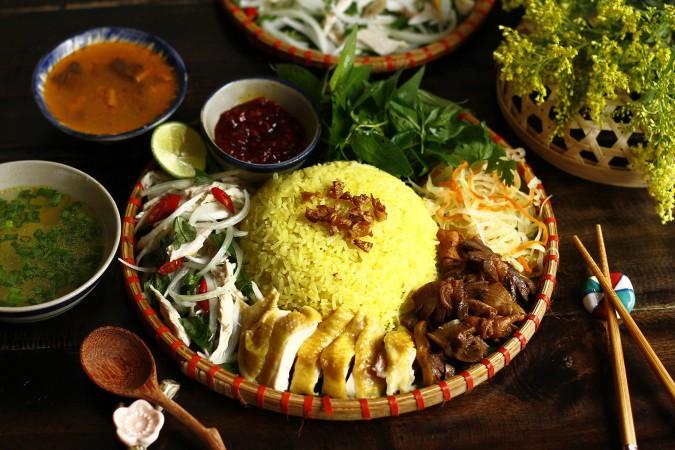
Hoi An Chicken Rice (Com Ga Hoi An) - © VnExpress
Festivals & Local Celebrations
The colorful festivals in Hoi An highlight the city's rich cultural legacy and civic spirit. These events provide a unique peek into local customs and unforgettable experiences for tourists.
Lantern Festival
Held on the 14th day of every lunar month, the Lantern Festival transforms Hoi An into a magical wonderland. Thousands of multicolored lanterns light up the streets, as villagers release floating lanterns into the Thu Bon river. Traditional music, dance performances, and games add to the festive atmosphere.
Mid-Autumn Festival
This holiday, held in September or October, is a time for family reunions and harvest celebrations. Children parade through the streets with lanterns shaped like animals and stars, while dragon and lion dances bring energy to the celebrations. Mooncakes, a traditional treat, are shared among friends and family.
Tet Holiday (Lunar New Year)
Tet is Vietnam's most important celebration of the year. Hoi An, together with other regions in the country, also considers it as a major event. The town is decorated with flowers, and families prepare special foods to welcome the new year. Lion dances, fireworks, and traditional ancestor rites are all part of the festivities.
Hoi An Full Moon Festival
Similar to the Lantern Festival, this monthly event involves turning off electric lights and illuminating the Old Town with lanterns. It’s a beautiful and serene experience that highlights the town’s traditional charm.
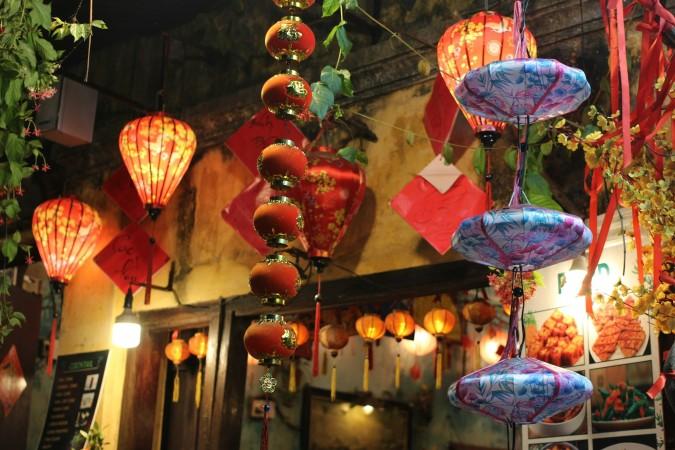
Lantern Festival - © John McFetridge
What to Do in Hoi An
Hoi An has a diverse choice of activities to suit a variety of interests, ensuring that every tourist has something to enjoy.
- Lantern Making: Engage in a hands-on workshop where you can learn to make Hoi An’s famous lanterns. These classes provide insight into the town’s traditional craftsmanship and allow you to create a unique souvenir.
- Thu Bon River Cruise: Experience the tranquility of Hoi An with a boat ride on the Thu Bon River. This scenic journey offers stunning views of the town’s architecture and lush countryside.
- Hoi An Cycling Tours: Explore the picturesque countryside around Hoi An on a cycling tour. Ride through rice paddies, visit local villages, and enjoy the natural beauty of the area.
- Scuba Diving and Snorkeling: Discover the underwater world at the nearby Cham Islands. These activities offer a chance to see colorful coral reefs and diverse marine life.
- Hoi An Market Tours: Join a guided tour of Hoi An’s bustling markets. Learn about the fresh ingredients used in Vietnamese cuisine and interact with friendly vendors.
Shopping in Hoi An
Shopping in Hoi An is a delightful experience, offering a mix of traditional crafts and modern goods. The town’s markets and shops are perfect for finding unique souvenirs and gifts.
- Hoi An Night Market: Located along the Thu Bon River, this market comes alive in the evening with stalls selling lanterns, jewelry, clothing, and street food. The dynamic atmosphere and diverse selection of merchandise make it a must-visit place when traveling to Hoi An.
- Central Market: This bustling market is ideal for those looking to experience the local way of life. Here, you can find fresh produce, seafood, spices, and handmade crafts. It's a great spot to improve your skills in bargaining while also immersing yourself in Vietnam's traditional market culture.
- Hoi An Tailor Shops: Hoi An is renowned for its tailoring services. Get custom-made clothing from one of the many reputable tailor shops in town. From suits to dresses, you can have garments made to your exact specifications.
- Handicraft Shops: Explore shops selling traditional handicrafts, such as silk lanterns, pottery, and lacquerware. These items are perfect for taking a piece of Hoi An’s artistic heritage home with you.
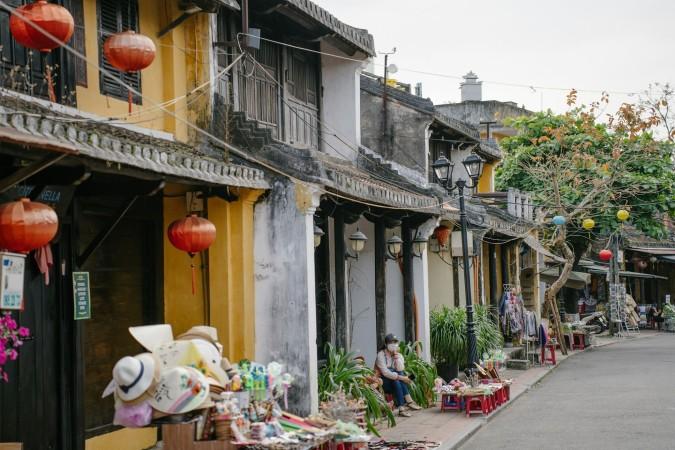
Hoi An Street - © Hoi An Photographer
Weather in Hoi An: Best Time to Visit
By understanding Hoi An's weather conditions and tourism trends, you can plan your trip to the city to align with your preferences, ensuring a comfortable and enjoyable visit.
Spring in Hoi An
- Weather: Spring in Hoi An brings mild and pleasant temperatures, averaging between 22°C (72°F) and 28°C (82°F), making the humidity lower and less rain.
- Tourism Trend: This is one of the best times to visit Hoi An. The comfortable weather attracts many tourists, leading to vibrant street markets and lively festivals. Booking accommodations in advance is advisable due to higher demand.
Summer in Hoi An
- Weather: Summer is the hottest time of the year, with temperatures soaring up to 35°C (95°F). Humidity is high, and there are occasional afternoon showers.
- Tourism Trend: Despite the heat, summer remains popular among visitors, especially beach lovers. An Bang and Cua Dai beaches are bustling with activity. Carrying sun protection and staying hydrated is essential. This season also sees a spike in local tourism as Vietnamese families travel during school holidays.
Autumn in Hoi An
- Weather: Autumn brings colder temperatures that range from 24°C (75°F) to 30°C (86°F) and also is the beginning of the rainy season, with increased chances of showers and occasional typhoons.
- Tourism Trend: This period sees fewer tourists due to the unpredictable weather, making it a great time for those seeking a quieter experience. Accommodation prices tend to be lower, and the lush, rain-fed landscapes offer a different kind of beauty. Ensure to check weather forecasts and pack accordingly.
Autumn is also the best season to visit Hanoi, the capital of Vietnam. Learn more about what to do in Hanoi in our article here.
Winter in Hoi An
- Weather: Winter in Hoi An is characterized by cooler temperatures, ranging from 18°C (64°F) to 24°C (75°F). Rainfall is more frequent, but it usually comes in short bursts.
- Tourism Trend: This season attracts tourists looking to escape colder climates. The colder weather is ideal for touring the Ancient Town and participating in outdoor activities. Holiday decorations and Tet Holiday (Lunar New Year) preparations add a festive charm to the town. Advance bookings are recommended for the Tet period due to higher tourist inflows.
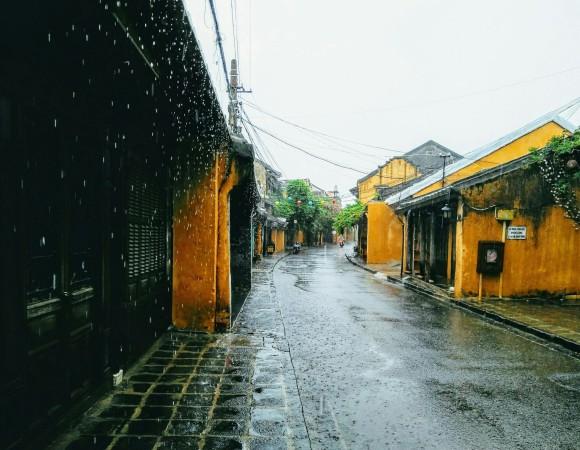
Raining season in Hoi An - © Phú Nguyễn Đạt
Culture Etiquette in Hoi An
Understanding and respecting local customs and etiquette will enhance your experience in Hoi An and help you connect with the community more meaningfully.
- Dress Modestly: While Hoi An is a tourist-friendly town, it is respectful to dress modestly, especially when visiting temples and religious sites. Cover your shoulders and knees.
- Greetings: A simple nod or a slight bow is a common way to greet people. Handshakes are also acceptable especially in more formal circumstances.
- Remove Shoes: When entering someone’s home or certain establishments like temples, remove your shoes. Look for shoe racks or follow the locals' lead.
- Table Manners: When dining, wait for the oldest person to begin eating. It’s polite to offer food to others before serving yourself. Avoid sticking chopsticks upright in a bowl, as it resembles incense sticks used in funerals.
- Respect Traditions: Participate respectfully in local customs and traditions, and show appreciation for the culture by learning a few basic Vietnamese phrases.
Essential Travel Information
Getting Around Hoi An
Getting around Hoi An is easy and convenient, with several transportation options available. The Ancient Town is best explored on foot, allowing you to soak in the ambiance and discover hidden gems at a leisurely pace. Renting a bicycle is popular, with many hotels and guesthouses offering bike rentals for exploring the town and surrounding countryside. For those looking to cover more ground, motorbike rentals are a great option, but ensure you have the necessary license and always wear a helmet. Traditional taxis and ride-hailing services like Grab are readily available for longer trips or when carrying luggage. Additionally, exploring Hoi An by boat provides a unique perspective, with boat rides on the Thu Bon River or hiring a sampan to visit nearby islands.
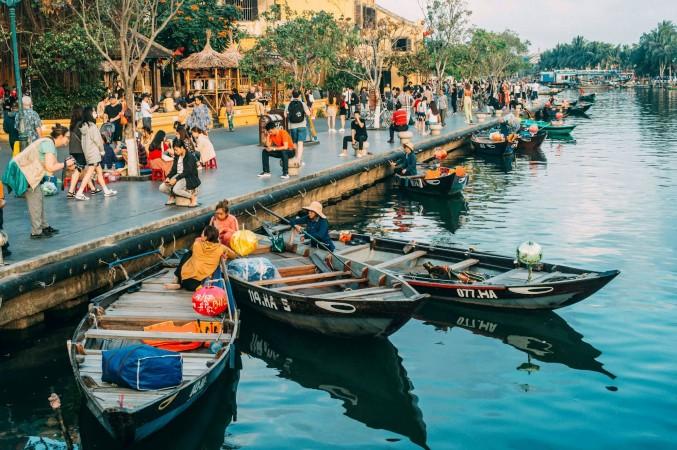
Boat riding in Hoi An - © Hoi An Photographer 호이안 사진 촬영
ATM & Banking Services
Hoi An offers a range of banking services to ensure visitors can manage their finances smoothly during their stay. ATMs are widely available throughout the town, especially in the Ancient Town area, and major international cards are accepted, making it easy to withdraw Vietnamese Dong (VND). Various banks provide services such as currency exchange and international money transfers. You can exchange foreign currency at banks, authorized exchange counters, or at the airport, while avoiding street vendors to ensure a fair rate. Credit cards are accepted in most hotels, restaurants, and larger shops, though it’s advisable to carry some cash for smaller establishments and street vendors.
Where to Stay in Hoi An
Hoi An offers a diverse range of accommodation options to suit various preferences and budgets, ensuring a comfortable stay for every traveler. Luxury seekers can enjoy high-end resorts with world-class amenities, including beachfront locations, spa services, and gourmet dining. For a more personalized experience, boutique hotels in or near the Ancient Town provide unique decor and easy access to main attractions. Budget travelers will find a variety of hostels that offer clean, comfortable accommodations and communal spaces for socializing.
Articles for you

Explore Yala National Park - Sri Lanka Travel, Asia
Tucked away in Sri Lanka’s southeastern corner, Yala National Park is where wild nature meets deep tradition. Known worldwide for its leopard population, the park is also home to elephants, sloth bears, crocodiles, and hundreds of bird species. Beyond wildlife, Yala opens doors to a cultural landscape dotted with ancient temples, Buddhist ruins, and coastal villages. For travelers seeking more than just a safari, Yala offers a chance to explore eco-tourism, local communities, and sacred heritage sites.
Population: The Yala National Park area doesn’t have a human population.
Economy: The economy around Yala National Park thrives on a blend of eco-tourism, agriculture, and local services. Safari tours, eco-lodges, and cultural experiences drive steady income for nearby towns like Tissamaharama and Kataragama, supporting thousands of families.
Landmarks: Famous for Block I of Yala and wildlife encounters, including elephants, sloth bears, crocodiles, and exotic bird species.

Explore Galle - Sri Lanka Travel, Asia
Nestled on Sri Lanka’s southern coastline, Galle is a vibrant city where history meets the sea. Its cobbled streets, colonial architecture, and serene beaches make it a must-visit destination for travelers seeking a blend of culture, adventure, and relaxation. A UNESCO World Heritage site, Galle captivates visitors with its Dutch Fort, bustling markets, and friendly locals. Whether you’re exploring the ramparts at sunset or savoring fresh seafood by the shore, Galle promises an unforgettable journey into Sri Lanka’s heritage.
Population: Approximately 113,000 in 2023.
Economy: Galle’s economy thrives on tourism, trade, and fisheries. The city’s historic fort, colonial architecture, and coastal charm draw thousands of international visitors each year, making tourism its main economic driver. Fishing remains vital for local livelihoods, supplying fresh seafood across the region.
Landmarks: Famous for the Galle Fort, Dutch Reformed Church & Maritime Museum, and Unawatuna Beach.

Explore Bentota - Sri Lanka Travel, Asia
Nestled along Sri Lanka’s southwestern coast, Bentota is a tropical paradise that blends golden beaches, vibrant culture, and thrilling adventures. Famous for its calm waters, luxury resorts, and scenic river estuary, Bentota has become a top destination for travelers seeking both relaxation and authentic experiences. From serene beach walks at sunrise to adrenaline-pumping water sports, this coastal town offers a perfect balance of leisure and exploration. With its proximity to Colombo and Galle, Bentota is easy to reach, making it an ideal stop for both short escapes and extended holidays.
Population: Approximately 37,000 in 2023.
Economy: Bentota’s economy thrives mainly on tourism, which drives local businesses such as hotels, restaurants, and wellness retreats. The town also benefits from fishing, coconut cultivation, and handicrafts like wood carving and batik textiles. Many residents rely on the growing demand for water sports and Ayurvedic treatments, making tourism the backbone of both income and employment in the area.
Landmarks: Famous for Bentota Beach, Bentota River Safari, and Kande Vihara Temple.

Explore Mirissa - Sri Lanka Travel, Asia
Mirissa is a charming coastal town on Sri Lanka’s southern shoreline. Known for its golden beaches, turquoise waters, and vibrant marine life, it has become a must-visit stop for travelers exploring the island. Many come for whale watching, surfing, and sunset views at Coconut Tree Hill, but Mirissa offers much more than postcard beauty. The fishing boats you see anchored by the bay carry generations of stories. Local traditions, delicious cuisine, and a laid-back rhythm of life shape every visitor’s experience.
Population: Approximately 4,700 in 2023.
Economy: Mirissa’s economy is largely shaped by its coastal location. Fishing has long been the backbone of local livelihoods, with generations relying on the Indian Ocean for income. In recent decades, tourism has become the main driver of growth, thanks to whale watching, surfing, and beachside hospitality.
Landmarks: Famous for Mirissa Beach, Coconut Tree Hill, and Parrot Rock Bridge.

Explore Nuwara Eliya - Sri Lanka Travel, Asia
Tucked away in the Central Highlands of Sri Lanka, Nuwara Eliya is often called “Little England”. With its rolling tea plantations, cool misty mornings, and colonial charm, this mountain town feels like a step into another world. Travelers come here to breathe fresh air, walk through flower gardens, sip the finest Ceylon Tea, and enjoy a pace of life far from the island’s busy cities. Whether you’re drawn by scenic landscapes, heritage architecture, or the warmth of its people, Nuwara Eliya is a destination that blends nature, culture, and history in perfect harmony.
Population: Approximately 781,000 in 2023.
Economy: Nuwara Eliya’s economy thrives mainly on tea production, as it sits in the heart of Sri Lanka’s central highlands, famous worldwide for Ceylon Tea. The city also benefits from a growing tourism industry, attracting visitors with its colonial charm, cool climate, and scenic landscapes.
Landmarks: Famous for Gregory Lake, Hakgala Botanical Garden, and Victoria Park.

Explore Sukau - Malaysia Travel, Asia
Nestled on the banks of the Kinabatangan River in Sabah, Malaysian Borneo, Sukau is a destination where wildlife, culture, and conservation come together. Known as one of Asia’s top spots for river safaris and eco-tourism, this quiet village offers a front-row seat to encounters with Bornean orangutans, pygmy elephants, proboscis monkeys, and exotic birdlife.
Population: Approximately 1,400 in 2019.
Economy: Sukau’s economy is shaped by its riverine location and natural resources. Traditionally, the Orang Sungai community relied on fishing, small-scale farming, and forest gathering for their livelihood. Today, the village has shifted toward eco-tourism, with river cruises, jungle trekking, and homestays providing income.
Landmarks: Famous for the Kinabatangan River cruises, Gomantong Caves, and Ox-bow lakes and wetlands.
